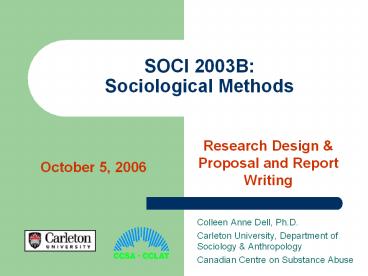SOCI 2003B: Sociological Methods - PowerPoint PPT Presentation
1 / 18
Title:
SOCI 2003B: Sociological Methods
Description:
Carleton University, Department of Sociology & Anthropology. Canadian Centre on Substance Abuse ... Descriptive. Explanatory. Application. What/Who are You ... – PowerPoint PPT presentation
Number of Views:21
Avg rating:3.0/5.0
Title: SOCI 2003B: Sociological Methods
1
SOCI 2003BSociological Methods
Research Design Proposal and Report Writing
October 5, 2006
- Colleen Anne Dell, Ph.D.
- Carleton University, Department of Sociology
Anthropology - Canadian Centre on Substance Abuse
2
OUTLINE
- 1. Choosing a Research Problem
- 2. Purposes of Research
- 3. What/Who You Are Researching The Unit of
Analysis A. Getting Started The Literature
Review B. Units of Analysis - Common
Errors - 4. The Time Dimension of Research The Question
of When - 5. The Research Proposal
- 6. The Research Report A. Characteristics of
Poor Report Writing B. 3 Basic Considerations in
Report Writing C. Organization of the Report
3
- WORKSHOP
- Distribute Research Project Assignment
- Guest Speaker Jane Fry Accessing the
Carleton University Data Centre, 430, Room 235,
MacOdrum Library
4
1. Choosing a Research Problem
5
2. Purpose of Research
- Exploratory
- Descriptive
- Explanatory
- Application
6
What/Who are You Researching UNITS OF ANALYSIS
- A. Getting Started The Literature Review
7
- Units of Analysis
- Those units or things we examine in order to
- create summary descriptions of all such units and
- to explain differences among them.
- 1. INDIVIDUAL 2. GROUPS 3. FORMAL
POLICITCAL/SOCIAL ORGANIZATIONS 4. SOCIAL
ARTIFACTS
8
What is the unit of analysis in the following
research projects? (Individual group
organization social artifact)
- 1. Women watch TV more than men because they are
likely to work fewer hours outside the home than
men. - 2. Of the 130 incorporated US cities with more
than 100,000 inhabitants in 1960, 126 had at
least two short-term nonproprietary general
hospitals accredited by the American Hospital
Association. - 3. Though 667,000 out of 2 million farmers in the
US are women, women historically have not been
viewed as farmers, but rather, as the farmers
wife.
9
4. Some analysis during the 1960s predicted that
the rise of economic ambition and political
militancy among the residents would foster
discontent with the other main churches. 5. This
paper examines variations in job title structure
across work roles. Analyzing 1, 367 job titles
in the US, we investigated how and why lines of
work vary by State.
10
Common Errors
- ECOLOGICAL FALACY
- INDIVIDUALISTIC FALACY
- REDUCTOINISM
11
4. THE TIME DIMENSION OF RESEARCH THE
QUESTION OF WHEN
- Cross sectional
- Longitudinal (A) Trend studies (B) Cohort
studies (C) Panel studies - Retrospective
12
5. THE RESEARCH PROPOSAL
- Elements of a Research Proposal
- Problem or objective
- Literature review
- Subjects for study
- Measurement
- Data collection methods
- Analysis
- Schedule
- Budget
13
6. THE RESEARCH REPORT
- 1. You are communicating data and ideas to an
audience. This must be done clearly so the
audience can evaluate for themselves. Informed
reader. - 2. View your report as a contribution to social
scientific knowledge. - 3. Your report should serve the function of
stimulating and directing further inquiry. - However well designed and executed a research
project - is, its final impact will depend, above all, on
the quality of - the written report.
14
Characteristics of Poor Report Writing
- Content
- Organization/structure
- Spelling, etc.
15
3 Basic Considerations in Report Writing
- The audience
- The language/style
- People are judged on the basis of who they
- appear to be in their writing, and if what they
- write is pompous or fuzzy or disorganized, they
- will be perceived as all those things William
Zinsser - 3. Types of reports
16
c) Organization of the report
- Tell them what you are going to tell them
tell them and them tell them what you told them
17
- 1. Title Page 2. Acknowledgements 3. Summary
4. Table of contents 5. Introduction Statement
of problem to be - investigated 6. Process of Discovery
a. Inception of the research b. Researchers
initial conceptual baggage 7. Theoretical
framework 8. Review of the literature 9.
Research Question (Identify the research
interest)
18
- 10. Methodology Research Design and Data
Gathering - The worth of all scientific findings are
dependent on the manner in which the data were
collected and analyzed - 11. Methodology Analysis and Interpretation
- 12. Summary and conclusions
- 13. Dissemination
- 14. Researchers Reflection
- 15. Appendix
- 16. Bibliography
- 17. Conceptual baggage file































